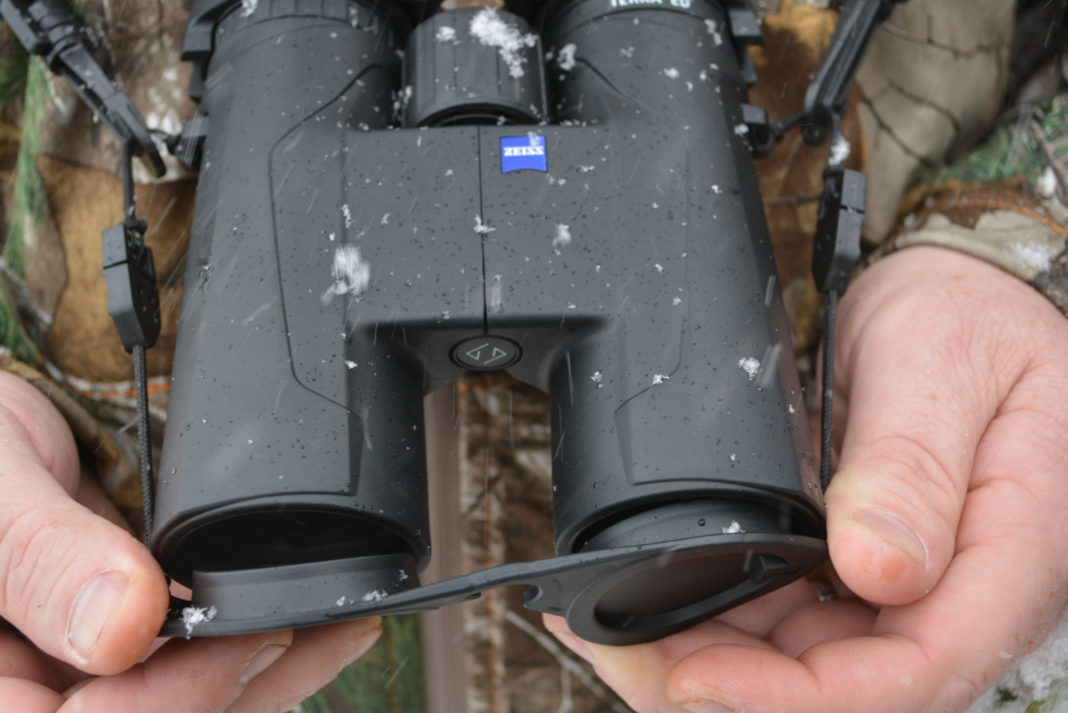Want to increase the field of view of your current binoculars? It’s easy. Instead of rolling out the eye cups of your binoculars (fully extending them), use them with the cups rolled down to expand your field of view. The field of view is decreased by going up in magnification or increased by going down in magnification. Example: 10×42 will have less field of field then 8×42.
 I had the privilege of hunting with Joel Harris, marketing and public relations director for Zeiss Sports Optics during the recent South Dakota blizzard. The freak storm was an absolute animal tragedy; an estimated 100,000 heads of cattle and horses froze to death. Animals littered Interstate 90, with some ranchers losing their entire herds.
I had the privilege of hunting with Joel Harris, marketing and public relations director for Zeiss Sports Optics during the recent South Dakota blizzard. The freak storm was an absolute animal tragedy; an estimated 100,000 heads of cattle and horses froze to death. Animals littered Interstate 90, with some ranchers losing their entire herds.
During the brutal storm, Harris and a few friends were holed up in a cabin, waiting out the storm so Harris put on a mini clinic about optics. Aside from the field-of-view tip, here are four more:
Exit pupil is the size or amount of light that’s transmitted through the optical device. This can be seen by holding the optical instrument at arms length and tilting slightly. You will see a small clear circle representing the light transmission. You may think that light is transmitted through the entire eye, yet just the round circle represents the size of light transmission.
Properly setting up binoculars to each individual’s eyes. The proper way to set or adjust binoculars for each individual is like reading a book — adjustment is made from left eye to right eye. First, select an object roughly 20 to 30 yards away. Closing your right eye, use the center focus wheel and adjust it until the object becomes crystal clear. Then, viewing the same object, close your left eye and use the dioplar setting found on most binoculars around the eyecup area of the right ocular and focus until crystal clear. (In some cases, the dioplar adjustment may be fixed to the center focus wheel with a pop-out mechanism.) Now you have your focus set for viewing at any distance.
or adjust binoculars for each individual is like reading a book — adjustment is made from left eye to right eye. First, select an object roughly 20 to 30 yards away. Closing your right eye, use the center focus wheel and adjust it until the object becomes crystal clear. Then, viewing the same object, close your left eye and use the dioplar setting found on most binoculars around the eyecup area of the right ocular and focus until crystal clear. (In some cases, the dioplar adjustment may be fixed to the center focus wheel with a pop-out mechanism.) Now you have your focus set for viewing at any distance.
Test optics in stores. In most cases you’ll shop for new optics in a bright store or convention center. All optics appear to look crisp and clear, thanks to the very well-lit store or arena. To overcome this, adjust the optical instrument to your eyes as described above. Find a spot up in the rafters of the store or arena that appears too dark for your eyes to distinguish detail without enhancement; take your adjusted optical instrument and look at the same area. The better the optical glass and coating, the better you’ll see the details that you could not see with your eyes alone. Now do this with each brand you’re considering and the choice should be clear… no pun intended. Obviously price, size, and ergonomics will also have to be considered based on your needs and budget.
Parallax. What is it? Why is it important? We’ll soon cover this topic in a follow-up post. In the meantime, you can check out Harris’ products at sportsoptics.zeiss.com.



















![The Best Deer Camp Chili [VIDEO] Deer Chili Ingredients, Tomatoes, Chili Spices](/wp-content/uploads/2015/10/Deer-Chili-Deer-Camp-Recipe-218x150.jpg)
![How to Call Elk Early in the Season [VIDEO]](/wp-content/uploads/2016/08/byers003-218x150.jpg)




![Idiots Disturb Hunter: How Would You Have Handled It? [VIDEO]](/wp-content/uploads/2015/10/DSC00110-e1474487693878-100x70.jpg)
![Albino Buck Shocked to Shed His Antlers [VIDEO]](/wp-content/uploads/2015/10/AlbinoDeer-100x70.jpg)